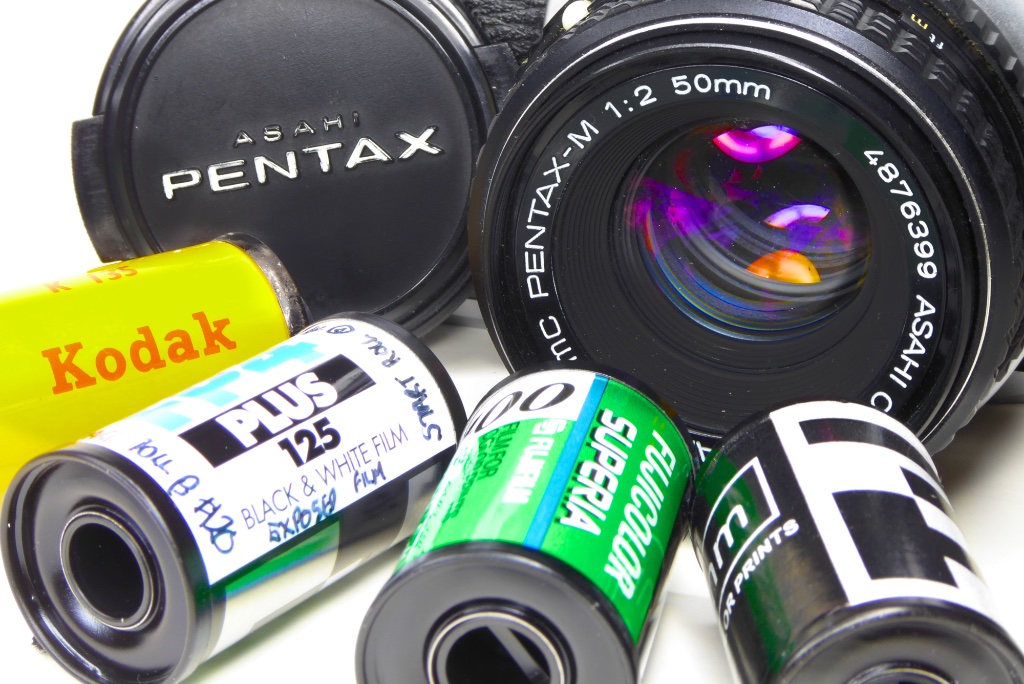
Pentax Film Camera Project :- Over the past 12 months there has been a flurry of speculation that Pentax would soon bring to market a new 35mm film camera.
Much of this has been provoked by some interviews with people at Pentax who are working on their film project. There are tons of speculative reports on this and doubtless with 5 minutes of searching online you will find the same interviews being rehashed in various forms.
Here’s our take on what we can expect coming soon, what we can expect coming later and why of all the manufacturers currently around Pentax would choose to launch film – it does make a kind of sense after all.
Before we get stuck into speculation lets take a quick look at the Pentax history.
In 1957 Pentax pretty much created the 35mm film camera that we all came to know and love. Their basic design stood the test for nearly 40 years and the same basic layout was used, with a few notable exceptions, by every major 35mm SLR film camera manufacturer.
In 1964 the Pentax Spotmatic launched, which built on the basic layout of the original Pentax camera and lasted until 1975 when Pentax launched the ‘K’ series. The flagship KX has been all but forgotten among modern film users but it was pioneering stuff in its day. Silicon photo diodes for it light meter and the then radical departure (for Pentax) from the classic M42 screw mount to the new ‘K’ mount from which the series derived its name. The budget camera from the series was of course the K1000 – built to a lower specification than the KX for students and the financially constrained.
From the original Pentax to the K series the cameras were built like a tank, solid, heavy and reliable but after the arrival of the Olympus OM-1 all manufacturers looked to shrink down their offerings to dinky sizes. The Pentax solution was the MX. One of the very last all mechanical, manual focus SLRs.
The budget K1000 trudged on until 1997 making it a contender for the last manual focus 35 SLR though the Minolta X-300 can also lay claim to that title and probably does pip the K1000.
So you can see Pentax were there at the start and there right at the end of the all mechanical 35mm film cameras.
It’s written into their DNA.
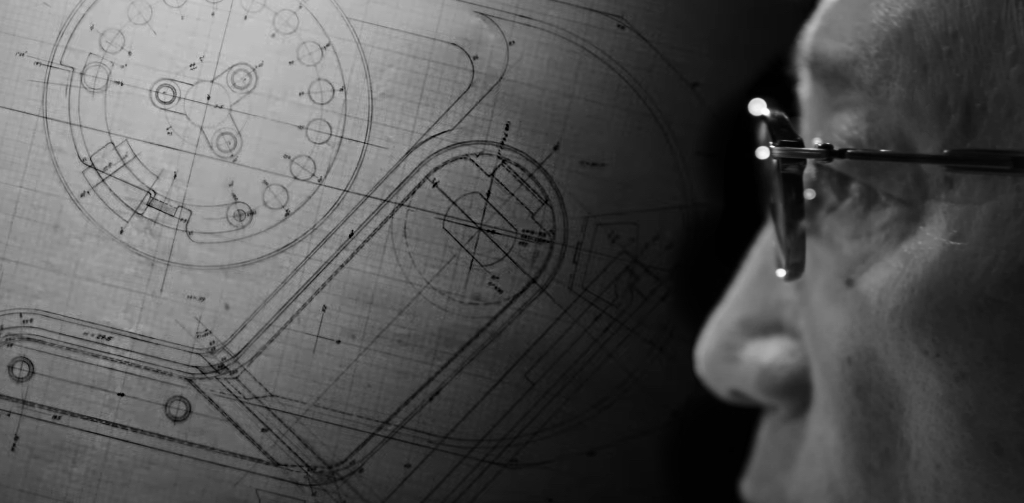
So why start making film again?
Of the big 5 manufacturers in the heyday of Japanese cameras Pentax have been the only player to not be terribly successful in the world of digital cameras. Their digital offering, while amazingly sophisticated has just lacked the heavyweight punch of Canon and Nikon. Minolta of course ceased making cameras altogether in 2006.
With a rise of interest in film and weakening sales in their digital line it makes sense for Pentax to be the first mover in getting back to film to try and capture a potential emerging market. There are rumours that Nikon are also looking to get a film camera back into production. There’s also some sense here, as Nikon are probably still smarting from losing out to Canon way back. Nikon did indeed make a limited edition redux of one of their early rangefinders. Prices were astronomical and production was severely limited to the availability of parts they had left over in inventory. We don’t doubt Nikon are also eyeing the film market.
So why is it taking so long?
Well, putting even a simple compact point and shoot together needs a fair amount of work. Lenses have to be designed and here’s the biggest problem. No one has had to design a film transport mechanism for 30+ years. Older designers and experts have retired and the word from Pentax is that they had a lot of problems. Modern designers had not realised just how complicated it is. The Pentax Film Camera Project team admitted they had to get people out of retirement to get the mechanisms debugged and working. Anyone who has had the guts of a camera to pieces will appreciate theres a fair amount of springs and gears needed to make it all work. Unlike the golden age when there was a base of existing products to build on and designers and engineers were still around this time it’s all having to be done from scratch.

To the simple, all things are simple. After all it’s only winding film from one end of the camera to the other isn’t it?
Well the short answer is no. As the take up spool in the camera increases in size as more film gets wound on the camera has to have gears that allow for that so the frame sizes stay the same. The sprocket winding the film through the mechanism has to stay in synch with the take up spool which is getting bigger with each picture you take. In addition the gears have to wind on the frame counter and arm the shutter. It all makes for a big challenge in mechanical engineering.
Whats the plan?
From all the hype it would seem that Pentax are most likely to develop a simple compact in the first go. From reading all the announcements and pronouncements we are thinking something very basic. Probably manual winding, fixed focus and probably not too far from the current Kodak offering though perhaps with better optics. Pentax have since suggested there will be four cameras in the initial line up so we think that will come out to be probably a very base level point and shoot either fixed focus or basic auto focus and built in flash. Probably a more de-luxe version with autowinding and here’s the real gem – Pentax announced recently that one of the four will be a basic camera with a replaceable lens. So we could be looking at something akin to a K1000.
From the point and shoot side of things we’d imagine Pentax will aim low on spec but high on quality. It’s typical for the far east to start with something simple that they know they can get right and reliable. The Japanese makers are never shy of running a ‘back margin’ – eg selling below cost to kickstart the market and then release version 2 with more features at a higher price to get any losses back. It’s the way the far east operates. Get the reliability and price right and then find out how to make money from it later.

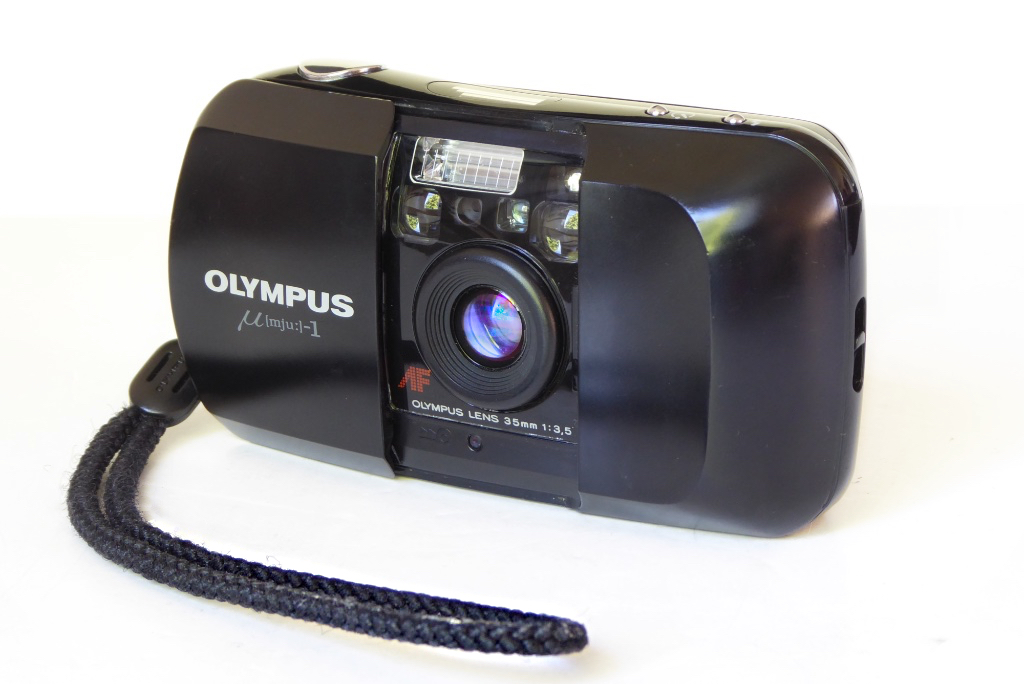
We expect something akin to the current Kodak line up at the start and probably something more akin to the vaunted Olympus mju:1 (also known as the Stylus) later on. The Olmpus mju:1 has a huge following and even clapped out examples will fetch £90 and up so its potential fertile ground to kickstart a new market.
While rebuilding a K1000 in its original form might be hard work it does kind of make sense. The late Chinese copies of the K1000 were primarily plastic. We could imagine it having a K mount lens fitting – it would make sense as there is still so many K mount lenses out there and frankly it would be hard to imagine Pentax would do it different – the K mount, like film, is in the Pentax DNA. They own the design and it would cut down the time needed to develop any lenses as they could simply repackage known designs. The design could be simplified and reduced rather like the Minolta X-300. It wouldn’t be hard to build program mode into it. When program mode first became available in the 1980s it was a tough one to do thanks to the electronics but today with custom chips you could build a manual focus camera with full program mode quite cheaply if the will were there to do it.

The Chinese were making clones of the Minolta X-300 right up to 2012 (probably pipping the K1000 as the last manual focus film SLR in production) and managed to strip the design down to just its basic essence and get the price low. The X-300 was a stripped down version of Minoltas premium X-700. Minolta cut down costs by using plastic, replacing complex and expensive mechanics with electronics and simplifying the top deck to speed construction and chip the price down. Theres no reason Pentax couldn’t do the same today.
What will the new Pentax camera cost?
Currently anyones guess. Our bet would be the compact would run around £100 to £200 and the SLR if it were to mature to a live product will probably run around £1,500 – maybe as high as £3,000. Much depends on what the Pentax game plan is and they haven’t’ really said much. If their game is make some cash then they will aim at premium but they will have problems there because who is going to spend £1,500+ on a new film camera when they could buy a rock solid classic like an original K1000 for around £200 or less. So a lot will depend on the feature set that Pentax have in mind and what their marketing plan is for these cameras.
As a guide to pricing in 1985 a Minolta X-300 cost around £125 – allowing for inflation that would mean it would cost around £400 today. BUT…. the premium cameras back then were closer to £400 which, allowing for inflation would mean a price of around £1,200 today. I’d very much suspect that the Pentax 35mm film SLR, assuming it comes to market will carry a premium tag price of at least a 40% uplift so that would equate to a tag price of around £1,700.
For Americans reading this just change the £ sign to $. It will be the same because Pentax will pitch to the $ price and when that stuff comes across the pond this kind of product will just do a 1:1 exchange.
When will we see the Pentax Film Camera Project deliver?
The Pentax Film Camera Project suggest 2024 will see the launch of the first four cameras so the next 12 months will be interesting for all of us film fans and users.
Dont be surprised if Pentax stay close mouthed or even misdirect and spoof. They will be as aware as anyone that the other manufacturers are watching closely.
One of the best kept secrets of the golden age of Japanese cameras was Minolta never telling anyone they had cracked auto-focus, in fact they never even said they were even looking at it. They let Pentax and Nikon bumble about showing prototypes that never really worked at trade fairs and then wallop! Delivered a killer punch to the market. It didn’t play out in the long run for Minolta. For us lovers of film lets hope Pentax have better luck.
Update 13th Jan 2024
A recent briefing by Pentax regarding future developments did not yield much information. Pentax are staying very close mouthed about the film project. As we said in the original article they are unlikely to show any cards just yet.
The industry as a whole is sceptical about this but with Pentax clearly struggling to stay relevant in digital it would make more sense than ever to get back to film.
A recent video the Pentax Film project released extolling the virtues of film showed, in a short clip, what could be something like a 35mm SLR in development.
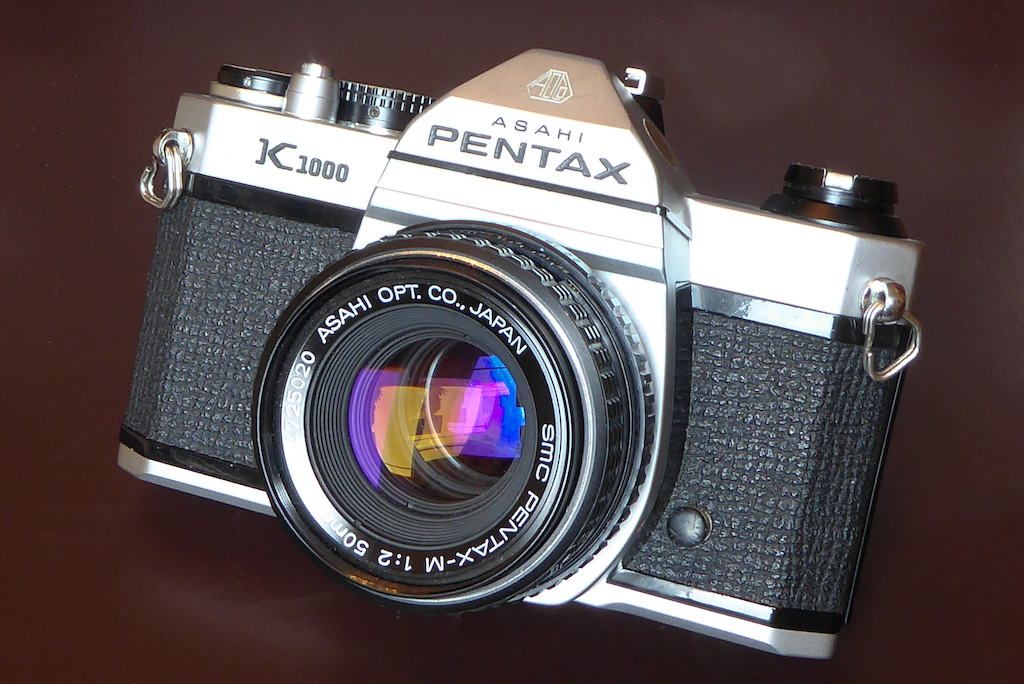
Responses from various film forums also show a large amount of scepticism but the common themes are very similar. Here’s our response to the most frequent sceptical comments.
1 Film is a Shrinking Market
Is it? This is heard from many forums these days but we would question that. Kodak most recently sold off a lot of its subsidiary and secondary businesses to invest in film production. Over 350 new staff have been taken on to support film production and Kodak are finding they simply can’t keep pace with demand. That doesn’t sound much like a shrinking market to us. Smaller than in its heyday? Of course it smaller than the glory days of the 1970’s and 1980’s but analyst expectation is for a steady growth in film. You can quibble the numbers but the fact is film is growing.
Harman, the owners of Ilford, have just invested in Phoenix – a brand new color film with a new emulsion. Numerous Chinese manufacturers are also ramping up. These are hard headed business decisions being taken. Yes they are undoubtedly a risk but our experience is that businesses seldom take big risks so they are in fact betting on a near certainty or at the very least a high probability of making money
2 Surely film uptake is just a blip
Again the question would be is it? People said the same about LP sales 20 years ago (what younger folk call vinyl) yet vinyl sales have increased steadily for the last 16 YEARS! Most modern artists release on to vinyl these days. 16 years worth of year on year record numbers can’t be considered a blip! With substantial increasing sales new manufacturers have come into the market to produce the hardware like record decks too. People find the sound is nicer, its more immersive and therefore more enjoyable to listen to. That kind of sounds like the same reasons people move into film cameras and away from digital.
3 There’s so many old cameras out there who will buy a new one?
The same people who currently buy record desks for vinyl – there are hundreds, probably millions of old record decks out there but after 40 years in an attic stuff breaks down. Just like old cameras.
Classic cameras from the 1970s were designed with servicing in mind. Few of them will ever have had it. Shutter speeds will be off by a mile on most of them plus internal seals will have failed in many cases. Some of this stuff is doable by the average person like the light seals but a Minolta SRT for example has 22 foam and rubber seals inside, these will have perished. Even the mighty Nikon F will start to lose accuracy, suffer prism rot and dried out lubrication. Who’s going to repair them for you? Most techs are now ageing and close to retirement. Last year alone saw three of the UKs few remaining techs pack it in for good. Even if you can find a tech spares are hard to come by and in some cases impossible. Whole model ranges and marques are now impossible to repair and that will only get worse as time goes by.
So, there are plenty of cameras out there for now – but who will be around to fix them for you?
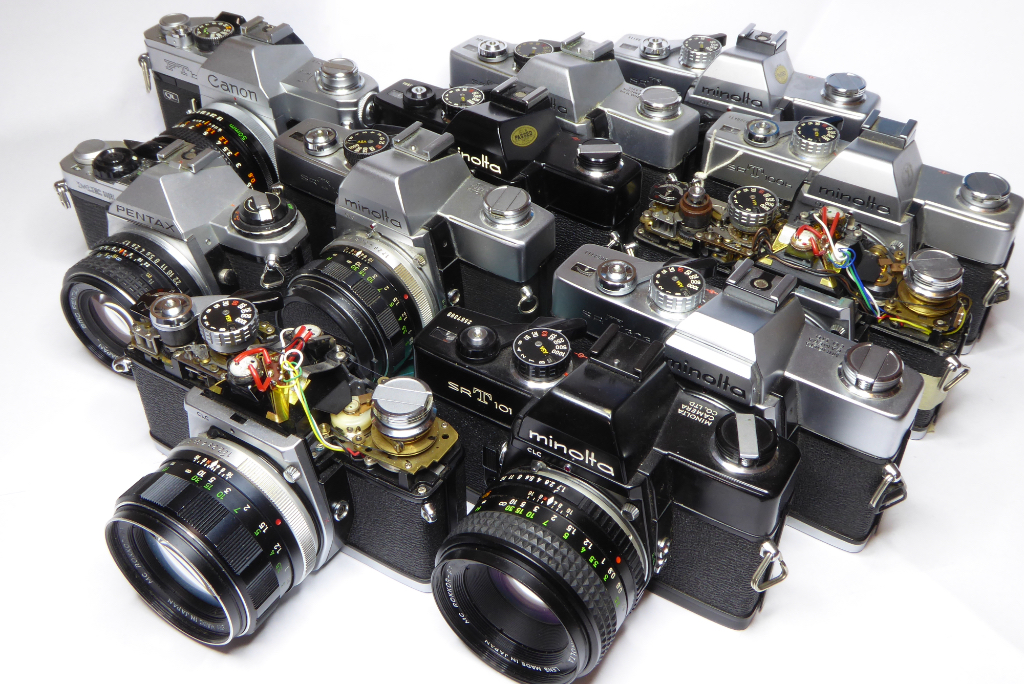
Lenses are another weak spot for film cameras. Many lenses from the 1970s suffer dried out lubrication, as the lubrication vaporises it deposits oil vapour onto the glass surfaces causing haze. Many lenses from the 1980s used encapsulated elements making repair or cleaning impossible. Earlier lenses survive better but even they can fall foul of terminal conditions like coating failure caused by fungus.
Just like vinyl – if film is to stay here people need to be making new stuff that’s reliable – the camera industry in its hey day turned out a few million cameras but it’s not infinite and as time goes by some of these, maybe most, will start to fail.
Certainly if film is to have a future there will need to be new products – Kodak and Harman aren’t going to stay making film if its just a few old farts shooting their classic Exacta or 1964 Spotmatic.
4. Surely the price of film makes it impossible to imagine it gaining ground again?
People keep raising the price of film as an argument. If you do an inflation calculation you will find the cost of most films is now not so different than it was in the 1970s.
An old magazine advertisment I found gives a price for a 36 exposure roll of HP5 at £1.80 in 1984. Using the Bank of Englands inflation calculator gives a price today of £5.71. Shopping around you can find Ilford HP5 at around £6 so yes its gone up slightly but it’s hardly that much more expensive and you can always opt for plenty of budget films out there for a lot less. Check out Mike Eckmans page here
Even allowing for the cost of some of the more exotic films they are still less than a cup of hot brown water and a mass produced muffin in one of the trendy (and pretty ghastly) coffee franchises.
I always find it odd that people will whine about the cost of film but are seemingly happy to part with a more substantial sums from some hot brown water or some nasty chemically produced beer which currently sells at £5.90 a pint in the UK. In part the price is undoubtedly down to shortage of supply but it would be fair to say the cost of raw materials has increased over that time.
The rising cost of film is in fact all the more reason why we all need a modern camera, or at least get old ones serviced while you still can. If the costs of taking a picture on film is in fact rising you really don’t want shots wasted thanks to an unreliable camera that suddenly exhibits shutter capping or a lens which is hazing badly.
5 It will be hugely expensive to design a new film camera
Well it would be expensive but not unreasonably so. Modern manufacturing techniques and CAD/CAM will cut the cost. Back in the 1960s many of these camera designs had to be done by hand, people actually drawing the parts up using a pen and paper. Skilled staff were needed to make the parts and more skilled staff were needed to assemble the parts into the camera. Development of a new model could take two years (the Minolta XE was almost 10 years in development!) because prototypes had to be made as one-off models. Today a lot of the work can be done on a computer, prototypes can be 3D printed or CNC machined very rapidly. Pentax have by their own admission struggled because some of the know how has been lost but once they are over the hump they will speed up exponentially.
Lens design like the mechanics can be done very quickly these days with CAD systems.
Compared to the cost of silicon chip design and manufacture a mechanical camera and lenses wont be THAT expensive to design and of course should Pentax go the K mount route that will cut lens design time down considerably.
A good comparison here is telescope manufacture. Back in the 1960s companies like Unitron (then in their heyday) charged a huge amount for their wares. Manufacturing telescope lenses and tubes created virtually a hand made product. Today companies like Synta in China can turn out a vastly better spec telescope in lens sizes that amateurs back in the 1960s could only dream about for not much cash. Parabolic mirrors which back in the 1960s were the preserve of serious observatories and NASA are now readily available at specifications that would be have been beyond scientific grade back then. And remember the amateur astronomy market is quite tiny.
We’d find it hard to believe there is a sufficient market size that allows modern lens companies like Synta and Televue to produce an ever more amazing array of gear for a tiny number of people who do serious amateur astronomy and yet a similar sized market of film enthusiasts wont find a company willing to do likewise. Synta and Televue are having to push the very boundaries of whats possible with optics – a redux of a film camera from the golden age requires a lot less investment than developing a whole new generation of gear that pushes the limits of optical design every 12 months or so.
6 Is any of this real?
Well you better believe it. Industry reports are very divided but the overall outlook is film is growing at around 2.8% (it may be as high as 8% depending one which report you read and how you interpret the data) and the smart phone market is in decline as the market is now at saturation point. Many people are turning to something a bit more thoughtful than a phone to store their memories.
One of the headaches for analysts is that unlike days of yore when there were a few big players to keep an eye on and you could easily analyse their earnings reports these days there is a very fractured market space with a very high degree of segmentation. Yes you can easily find out what Harman or Kodak are up to from their sales numbers but you are blind to what’s happening at Orwo or Kosmo films or the two dozen other specialists producers of film products and of course no industry analysts are going to be looking at the sales volumes of second hand cameras from J.Bloggs Photo Mart so a lot of the analyst reports are guesswork. Our bet is the potential market is very much underestimated – lets hope so for a new film camera from Pentax.
Update 18th March 2024
Pentax announced on the 1st March that the new film camera will be a vertical format, half frame camera with zone focusing so we’d expect it to look more Konica Pop than anything. Pentax now predict Summer 2024 for release. The usual notices from Pentax about how terribly tough its been to get the technology back from the dustbin it was all consigned to years ago but some things have become more clear in their announcement if you read between the lines.
First off is the rationale for the film camera appears to be retro style for a younger audience so expect a low quality offering for retro style photos. The vertical format and half frame may play well though. The vertical format will make it seem more like a smart phone which may help make it look familiar and therefore more be appealing to younger buyers (If you have never seen a vertical format half frame so a web search for the Taron Chic). The half-frame format also saves on film costs as you’ll get 72 shots from a roll instead of 36 albeit at the expense of quality but the lower price will save on film costs so it makes sense for a younger market.
What was most interesting about the update from Pentax was their statement that they wanted some assurance that film would be available and they are now comfortable that film will be around so are now green-lighting this for production. Us film fans should take a measure of comfort from that because you can bet your prize camera that Pentax wouldn’t do a thing unless they had some solid assurance from the likes Kodak and Fuji that they weren’t planning on getting out of film anytime soon.
On forums it’s overall been a big thumbs down as people keep wittering on about who will buy a film camera given the fact that most people smart phones but here’s a thought for you. Back in the hey-day of film most people NEVER owned any sort of camera or at most a snap-o-matic point and shoot like a Kodak Instamatic.
Classic shooters today largely seem to forget that the prosumer and professional SLRs of yesteryear were always a very tiny market. You may think of classic cameras as being made in the millions but few ever were – many classic cameras were made in quite small numbers. There were a few exceptions but these were almost always cameras aimed at the low end of the market proving the point. Almost all camera production was geared to point and shoots. The point being that the people today blatting pics onto their smartphones were the people who back in the 1970s were never going to own any camera at all! The fact that most people didn’t own a camera or have any interest in owning one did not change the dynamics of the market back then and the idea that people who own a smartphone wont buy a camera wont change the market dynamics for a modern film camera today either – those are the people who simply were never going to buy a camera anyway either then or now.
As we have said before the best chances of keeping film alive are new products coming to market so we are wishing Pentax every success in this one. Anything which gets people interested in film has to ba a good thing.
Further reading

Mel is one of the driving forces behind High 5 Cameras and writes all our articles.
Starting serious photography back in 1972. Over the years she got to shoot film with most of the major brands in 35mm and large format as both a studio photographer and content provider for websites in the early life of the web. These days she is rediscovering photography and has become the GOTO person for knowledge on camera repair advice.



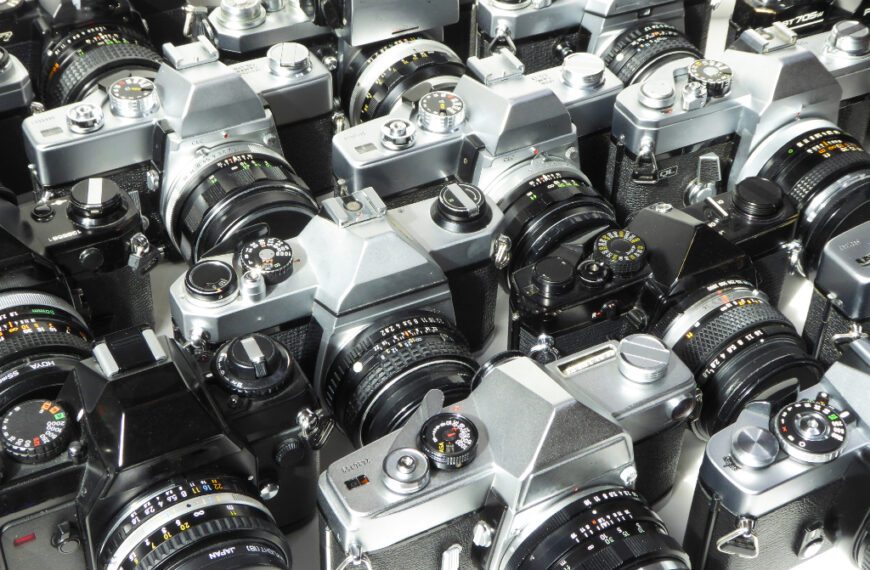
I am 76 year old person, grew up with almost every 35mm single pentax cameras and 6×7, 120 roll format too. I bought few pentax DSLR too and I was surprised to notice old Pentax fans do not follow the brand anymore. This will be very interesting to see the film camera fans will come back to Pentax brand or not, but I think it is a good move.
Well we think it will be good as well. Many people think its not needed as there are so many old cameras out there but the fact is many of these cameras are now unrepairable due to shortage of spares, and critically, a shortage of professional technicians who can repair these. We limit repair work to only a few cameras where we have sufficient spares stock to manage repairs.
In the UK the number of repair places that can manage repairs can easily be counted on one hand. Whole ranges of cameras are now unrepairable.
Our own thoughts are that if film is to have a future someone will have to start manufacturing. Film manufacturers are simply not going to keep going if their only market is people using classic cameras which is a very small audience.
I’m a big fan of Pentax film cameras from the mid to late 70s, and in general film cameras also from that era produced by Minolta, Olympus, etc. I hope the new film cameras that Pentax is putting out are amazing.
Quick question: I’m failing to understand from your article the take-up spool and sprocket winder mechanism and how the camera has to have gears that adjust for the amount of film on the take-up spool. Why would the amount of film on the take-up spool matter? Sure, the film builds up on the spool but the spool itself doesn’t actually increase in size. It doesn’t make sense to me and I can’t see how the two are related. Can you point me to an article that explains that more?
Hi, We can understand your confusion as regards the spool and clutch arrangement. It’s not an easy concept to grasp.
As film is wound onto the spool the spool increases in size. It’s not a huge amount but it is significant. Cameras which contain a ‘film safe’ indicator like the Minolta XD use this as a guide to register whether the film is transporting correctly by using a ‘feeler’ that is in contact with the film on the spool. The size increase of the spool as film gets wound on is not huge but it is enough, if not managed, to cause framing issues. If there were no clutch involved what would happen is there would be a large frame space between the first frames and no spacing at all on the last frames. In order to manage equal frame spacing across the roll the volume of film on the spool has to be taken into account. This is managed via a clutch arrangement on the camera which adjusts the amount of film being wound on with each successive frame. As the clutch takes into account the amount of film on the spool this naturally has an effect on the film feed sprocket.Simply put as the spool size increases the amount of film being wound on has to be adjusted to ensure equal frame and spacing sizes.
The gearing to make all this happen is both subtle and complex. Very often frame spacing issues on a camera are amongst the hardest issues to resolve.
I cant point you to a definitive source on this as each camera is different and the service manuals do not get involved in the basic theory in the way that car manuals do not explain the physics of internal combustion engines. The only source I could point you to would be the Society of Photo Technicians training course which you could find on learncamerarepair.com.
Sorry I cant be more help than that but it does go some way to explain just how hard it is to design these things.
It’s still to early to know for sure what Pentax are working on but we’d not be surprised to see something akin to a K1000.
Bets regards,
Mel
Glad to hear this. Kodak hired 24 7 shifts because they cannot keep up with the demand for film. I hope to get a Pentax med format film camera when I can afford it. The medium format digital cameras did not fair well maybe because of the crazy price. You can get them at a fraction of their initial prices now. Long live film.
We hear Fuji are now manufacturing again in the US but like Kodak they are struggling with demand. Dont forget there are lots of small boutique film producers like Kosmo Films and recently there have been new films from Chinese manufacturers for both 35mm and 120 format and Harman have also introduced ‘Phoenix’ – an entirely new colour film. Strangely although people think film is expensive in real terms it’s only about the same as back in the 1980s. Look out for a new article from us on film prices and also updates to the Pentax Film Project article.
Best wishes,
Mel
I’ve mailed Ricoh and they respond me that new film camera will come in summer. I’ve hope it will be something better than that Kodak. If they go that way it just a shoot in the knee. Market needs a very good point and shoot.
A point and shoot thats something like an Olympus Trip would be nice but many of us are really wanting a full on SLR and are hoping for a K1000 redux. Lets all keep our fingers crossed on this one.